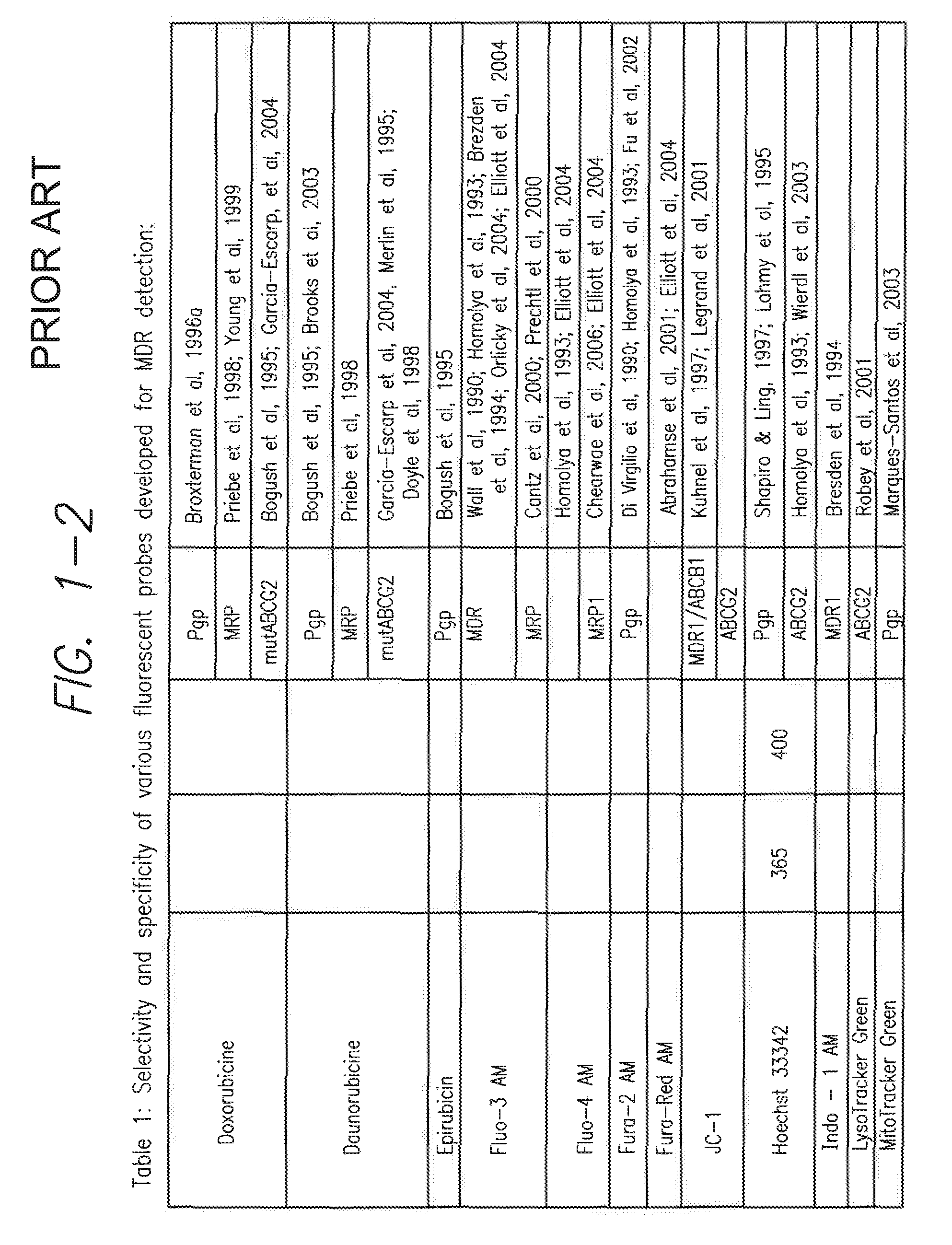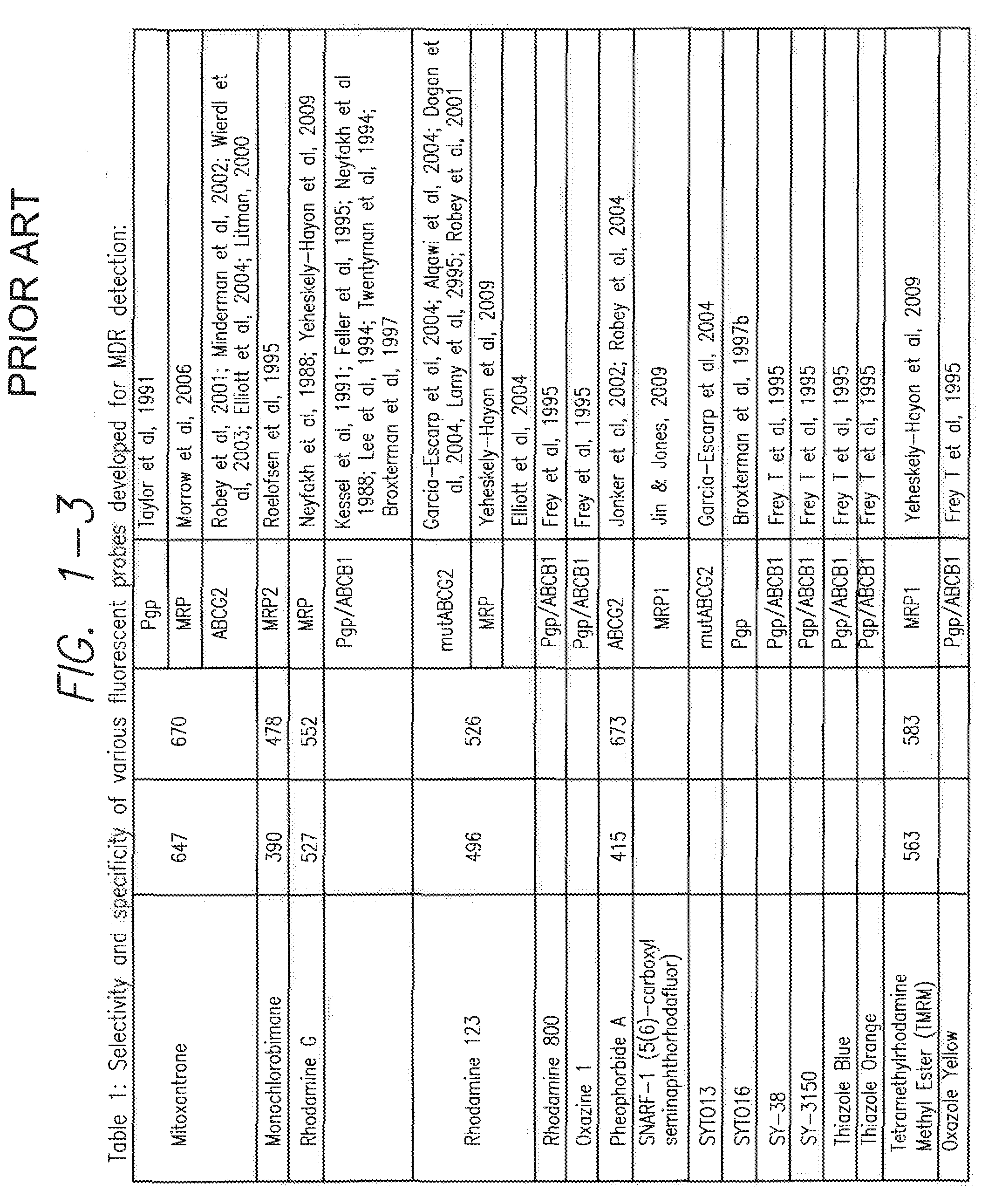Processes and kits for determining multi-drug resistance of cells
a multi-drug and kit technology, applied in the field of multi-drug resistance (mdr), can solve the problems of bacterial multi-drug efflux system, difficult to estimate the activity of abc transporter, and serious problems in the field of multi-drug efflux system
- Summary
- Abstract
- Description
- Claims
- Application Information
AI Technical Summary
Benefits of technology
Problems solved by technology
Method used
Image
Examples
example 1
Demonstration of Multidrug Resistance in Mammalian Cell Lines Using MTT Method
[0207]Human cervical adenocarcinoma epithelial cell line HeLa (putative MDR negative cell line), human lung carcinoma cell line A549 (over-expression of MPR1 and BCRP) [Sharenberg et al., Blood 99:507-512 (2002); McCollum et al., Cancer Res 68:7419-7427 (2008)]) and hamster ovary CHO K1 cell line (over-expression of all three major ABC transporter proteins) [Ling et al., Cancer Treat Rep 67:869-874 (1983); Gupta et al., Biochem Biophys Res Comm 153:598-605 (1988)]) were obtained from ATCC (Manassas, Va.). HeLa cells were routinely cultured in Eagle's Minimum Essential Medium with low glucose (ATCC), supplemented with 10% fetal bovine serum (ATCC) and 100 U / ml penicillin, 100 ug / ml streptomycin (Sigma-Aldrich, St. Louis, Mo.). A549 and CHO K1 cells were routinely cultured in F-12K medium (ATCC), supplemented with 10% fetal bovine serum (ATCC) and 100 U / ml penicillin, 100 μg / ml streptomycin (Sigma-Aldrich, S...
example 2
Minimal Fluo-8™ AM and Rhod-4™ AM Dye Toxicity
[0209]Human cervical adenocarcinoma epithelial cell line HeLa (putative MDR negative cell line), human lung carcinoma cell line A549 and hamster ovary CHO K1 cell line were cultured as described in the Example 1. Fluo-8™ AM and Rhod-4™ AM fluorescent probes were dissolved in anhydrous DMSO at the following concentrations: Fluo-8™ AM—1 mM (a 200× stock solution), Rhod-4™ AM—2 mM (a 1000× stock solutions). 1 mM (2000×) stock solution of Calcein AM was prepared for control measurements. Stock solutions of the dyes were aliquoted and stored at −20° C. in the dark.
[0210]Three model cell lines (CHO K1, A549 and HeLa cells) were seeded in 96 well plates (5×103 cells / well) and 24 h later were treated with the working concentrations of dyes (0.5 μM of Calcein AM, 5 μM of Fluo-8™ AM, 4 μM of Rhod-4™ AM) used in the MDR assay for 3 h at 37° C. Then reagents were removed and a standard MTT test was performed as described elsewhere [Mosmann T., J Imm...
example 3
Development of the Minimal Step Assay Procedure for the Dye Uptake Flow Cytometry Protocol
[0211]Human cervical adenocarcinoma epithelial cell line HeLa (putative MDR negative cell line), human lung carcinoma cell line A549 and hamster ovary CHO K1 cell line were cultured as described in the Example 1. All dyes stocks were prepared as described in Example 2. The following stocks of inhibitors in DMSO were prepared: 5 mM of cyclosporine A (general specificity inhibitor, 1000×), 5 mM of verapamil (MDR-specific inhibitor, 250×), 0.2 M of probenecid (MRP-specific inhibitor, 1000×), 10 mM of MK-571 (MRP-specific inhibitor, 200×), 0.5 M of novobiocin (BCRP-specific inhibitor, 10000×) and 10 mM of fumitremorgin C (BCRP-specific inhibitor, 1000×).
[0212]Cells were grown on tissue culture dishes and on the day of assay were trypsinized and washed twice with warm (37° C.) phosphate-buffered saline (PBS). Post-wash, the cells were re-suspended in warm phenol red indicator-free medium at a densit...
PUM
| Property | Measurement | Unit |
|---|---|---|
| temperature | aaaaa | aaaaa |
| temperature | aaaaa | aaaaa |
| pH | aaaaa | aaaaa |
Abstract
Description
Claims
Application Information
 Login to View More
Login to View More - R&D
- Intellectual Property
- Life Sciences
- Materials
- Tech Scout
- Unparalleled Data Quality
- Higher Quality Content
- 60% Fewer Hallucinations
Browse by: Latest US Patents, China's latest patents, Technical Efficacy Thesaurus, Application Domain, Technology Topic, Popular Technical Reports.
© 2025 PatSnap. All rights reserved.Legal|Privacy policy|Modern Slavery Act Transparency Statement|Sitemap|About US| Contact US: help@patsnap.com



